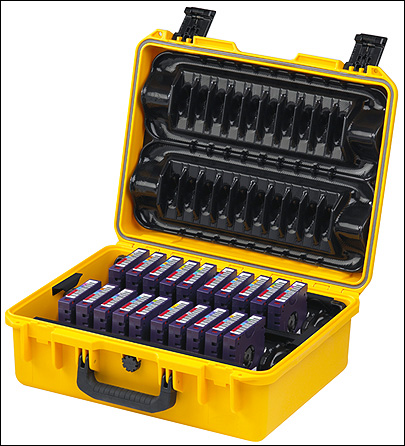A single data tape cartridge can hold hundreds gigabytes of sensitive information. “Our data storage cartridges can hold up to a terabyte of data, and that could contain hundreds of thousands of customer names and personal information,” explains Tim Bjork, Imation’s market development manager for removable data storage provider Imation.
Being able to track and secure data tapes is a capital concern for those companies responsible for such information, as data loss must be fully disclosed in compliance with federal mandates, and losing data often harms customer relationships and a firm’s public image. To help companies track tapes more efficiently and reduce the risk of losing them, Imation has developed DataGuard rf, a data tape management system utilizing passive, high-frequency RFID tags.

The product was designed for use by data center managers, most of whom currently identify and track data tapes using a 6-character number called a volser, written in the form of human-readable text or a bar code on a label attached to each tape. With DataGuard rf, these managers would use either handheld or fixed-position RFID interrogators to read the volser encoded to an RFID inlay, complaint with the ISO 15693 air-interface standard and embedded in a tape’s label, or to check a single tape or group of tapes into or out of a facility’s inventory. This would offer improvements over current systems, says Imation, by making tape tracking easier—RFID does not require a line-of-sight read, as bar codes do, and the technology can be used to read batches of up to 20 tapes simultaneously—and less prone to error since numbers would not be inaccurately recorded, as is possible with manual entry.
DataGuard rf is comprised of the RFID-enabled volser labels, along with handheld and fixed-position readers, both designed by Imation’s internal research and development team and made by undisclosed contract manufacturers. It also incorporates software to process the tag data, encode it and pass it on to one of two tape management system software platforms: Vault Ledger and Vertices, from data management software provider B & L Associates. The Vault Ledger is a Web-based software application designed for use by both the company that owns the data tapes and a third-party provider of a vault where the tapes are stored. The Vertices software is not Web-based and is designed for tracking data tapes across a single facility.
Imation has also developed a customized tape carrying case made of a rugged, shock-absorbing plastic material. “Traditional cases are metal, which blocks RF signals and would make the RFID inlays unreadable,” explains Bjork. The cases hold up to 20 Imation data tapes and fits onto a specially designed antenna, built into an Imation-designed platform, onto which the case is placed.
The DataGuard rf software also includes a function called watchlist, which enables data center managers to input single or multiple volser numbers of tapes that cannot be located. The DataGuard software e-mails managers an alert message the next time any missing tapes are read by any of the readers in the network. The managers can then track the tapes using the location or registered user of that reader as a guide.
In the second generation of the product, due out this summer, Imation plans to add in-transit visibility to the DataGuard rf system by embedding a cellular GPRS radio and a GPS device into the carrying case, in order to transmit the case’s GPS coordinates to the DataGuard user over a GPRS network. “This way, customers will be able to track the cases as they move between a data center and an off-site vault where the tapes are kept for back-up or disaster recovery purposes,” says Bjork. Should any of the cases be misplaced during transit—if, for instance, one were to fall off the truck transporting it—the DataGuard user would be able to zero in on the case’s location.
Imation is selling the DataGuard rf product kit with one handheld reader, one fixed-position reader and an antenna for reading cases of RFID-tagged tapes, along with 5,000 RFID-enabled tape labels, 10 tape carrying cases and an application program interface for either the Vault Ledger or Vertices software. The kit costs $40,000. According to Bjork, Imation also offers a retrofit labeling service for customers looking to RFID-enable tapes already in use, as well as installation services for the DataGuard rf system.

